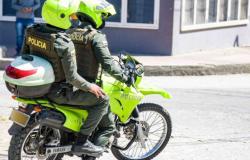The father Juan SolanaLC, director of Magdala Center, presented in Madrid on June 11 and 12 the Mary Magdalene Network (Magdalena Network), an initiative of “twinning between institutions around the world that have Mary Magdalene as their inspiration or patron” and whose purpose is “to find in Mary Magdalene a profound illumination on the dignity of women.”
On Tuesday the 11th, a public event was held in the Hall of Degrees of the CEU San Pablo University in Madrid, convened under the title Mary Magdalene, history versus myth. She introduced him José Miguel Abatsecretary of the Tierra Santa Foundation, organizer of the event with the collaboration of the Ángel Herrera Oria Cultural Foundation, on whose behalf its managing director said a few words, Fernando Lostao.
In addition to Father Solana, Ignatius Lovecoordinator of the María Magdalena Network, and the writers Jennifer Ristineauthor of several monographs on Mary Magdalene, and Maria Teresa Alvarezauthor of the novel Mary of Magdala.
On Wednesday the 12th, Father Solana and Ignacio Amor appeared before the media at a press breakfast to present the general lines of the initiative and its next steps.
Father Solana: “A profound illumination on the dignity of women”
Father Solana recalled the origins of Magdala Center, land next to the Sea of Tiberias acquired in 2006 and headquarters shortly after the archaeological discovery of the ruins of the city of Magdala and its synagogue from the 1st century (therefore, contemporary of Jesus), the only one from that time discovered so far. On the same day of the signing of the acquisition, the then archbishop of Liverpool, Patrick Kelly, who was in the Holy Land, encouraged Father Solana to “review the figure of Mary Magdalene”, specifically the hypothesis of having been a prostitute. Father Solana later valued these words as a sign of the fundamental role that this woman from the Gospels was going to have in the future of that enclave, where today the Duc in Altum temple and a hotel for pilgrims and soon an exercise house stand: “Everything that happened then there was a chain reaction.“said the religious man.
They have come to pass through Magdala until 300,000 visitorshe pointed out, and that means for them “a feedback of the impact of Mary Magdalene on thousands of people, and provides a very enriching perspective of Mary Magdalene.” In particular, Father Juan confessed that he entrusts the saint particularly “to people who need inner healing”
He also cited two important interventions by Pope Francisco around Mary Magdalene. First of all, elevating her “liturgical memory of her” to a “liturgical feast,” at the level of the apostles, and characterizing her as “apostle of the apostles.” And second, separating its celebration from that of the brothers Lazarus, Martha and Mary, friends of Jesus, as a way of differentiating Mary of Bethany from Mary Magdalene, characters who have sometimes been confused, and giving the latter “its own weight, his own message.”
Father Solana recalled that Jesus Christ entrusted Mary Magdalene, now Risen, with the transmission to the disciples “of a message that is equivalent to the entire Gospel: ‘Go to my brothers and tell them that I am going to my Father who is your Father, to my God who is your God’ (cf. Jn 20, 17). He places us at the level of relationship that He has with his Father, restoring our dignity.”
Father Juan Solana, director of Magdala Center.
Jesus preceded those words with the appellation “Woman,” to refer to Mary Magdalene. There is “a very great theological content” in those words of Jesus, Father Solana pointed out, content that Benedict XVI glossed “in two beautiful homilies.” “In Mary Magdalene,” Father John concluded, “Christ is ‘resetting’ the concept of woman”.
He aim of the Mary Magdalene Network is, in that sense, and focusing exclusively on what the Gospel says (eleven quotes, the woman most mentioned in by the evangelists), constitute “the solid core of a spirituality that does not get lost in the twists and turns of interpretations.” The character of Mary Magdalene, he explained, “is like an olive tree that has grown wild and must be pruned so that it grows better” and thus, in particular, “offers a profound illumination on the dignity of women”.
Ignacio Amor: “A project that leads to God”
On several occasions, Father Solana called Ignacio Amor, coordinator of the María Magdalena Network, as the “spark” that had lit the fuse of this project. The María Magdalena Network, Amor himself explained, was an idea long cherished by Father Solana, which he learned about after years of historically and graphically documenting the abundance of churches, hermitages and images of María Magdalena on the different routes of the Camino. from Santiago.
“My focus was not to do reports,” Amor detailed, with very emotional words, “but to study how the figure of Mary Magdalene could inspire me. This project has been configured as something that leads to God. “Mary Magdalene is helping me get closer to God”.
Ignacio pointed out that there are thousands of cathedrals, churches, parishes, hermitages, brotherhoods, brotherhoods, etc., that throughout the world have Mary Magdalene as their patron saint. He is beginning to contact all of them, and the response is being abundant and enthusiastic.
Ignacio Amor, coordinator of the María Magdalena Network.
In December there is already dated and organized a pilgrimage to the Holy Land with several people interested in the María Magdalena Network, who will get to know Magdala in depth and will hold several work sessions to set objectives for the coming years and establish guidelines and statutes to meet them.
The María Magdalena Network makes a contact email available to all those interested in being part of it: [email protected]
During the presentation of the María Magdalena Network, in Madrid.
Jennifer Ristine: “A healed woman to whom Jesus entrusts a mission”
Jennifer Ristine, author of several academic works on Mary Magdalene, highlighted the need to study her figure “with humility to know that no one has the absolute truth about her”, since strictly evangelical data are few. Ristine exposed some of those that are known for sure.
Was freed from seven demons“although it is highly debated what those demons were”: “What is clear is that she was a woman in need of liberation, which is why she is very suitable for a spirituality consisting of promote the ontological dignity of the personregardless of what is in your past or may be in your future.”
She accompanied and supported Jesus “with her own resources,” that is, “she had something to contribute,” which indicates her own high social status, before her conversion, “more of a courtesan than a prostitute.”
Jennifer Ristine, author of several monographs on Mary Magdalene.
Was “loyal and faithful to the foot of the Cross”, and received the privilege of his encounter with the Risen Christ and the message that He asked him to transmit.
Jennifer reiterated these two concepts as keys to a spirituality based on Mary Magdalene: “It is a woman who needs to be healed and to whom Jesus entrusts a mission”: “Let us not stay, then, in the secondary thing that is discussed about her or the historical traditions about what she did after the Resurrection, but let us stay with the essential, that is, that she was a woman who found dignity.”
María Teresa Álvarez: “The strongest, bravest and most faithful of the disciples”
Maria Teresa Alvarez is the author of Mary of Magdala, a novel published by La Esfera de los Libros that has a specific origin: “The influence that Magdala and the Sea of Tiberias had on me.” And a meaning: “Jesus is the character in history who has done the most for womenand has defended all women in the person of Mary Magdalene.”
Álvarez portrays her in two worlds, before and after the moment in which she meets Jesus “and her life changes.” She was the first person in the Gospels who meets the Risen Jesus and is commissioned to tell others about it: “Of all her disciples, she was the strongest, the bravest and the most faithful.”
María Teresa Álvarez, author of the novel María de Magdala.
María Teresa explained that composing her novel had been “very difficult,” because it was written in the first person, with all that this entails of internalizing episodes such as “the suffering of Calvary or the joy of the Resurrection, two pages that took me two weeks.” ”. But that effort has been worth it: “It has done me good, it has helped me in my personal relationship with the Lord”.
Room photos: IM
Contact María Magdalena Network: [email protected]
Contact Holy Land Foundation: [email protected]
Magdala Center: https://www.magdala.org/es
Holy Land Foundation: https://fundaciontierrasanta.es/
(Article originally published on the Holy Land Foundation portal).






